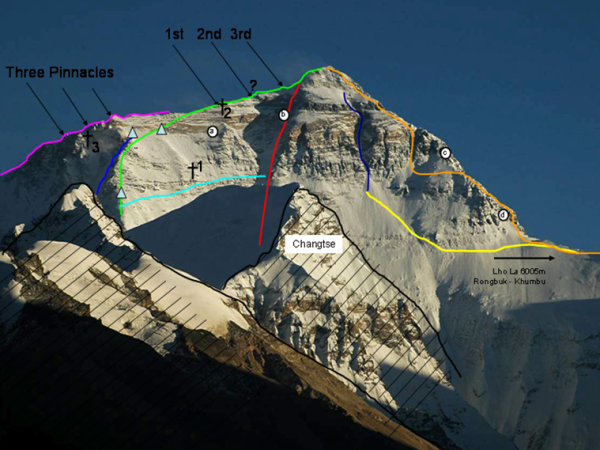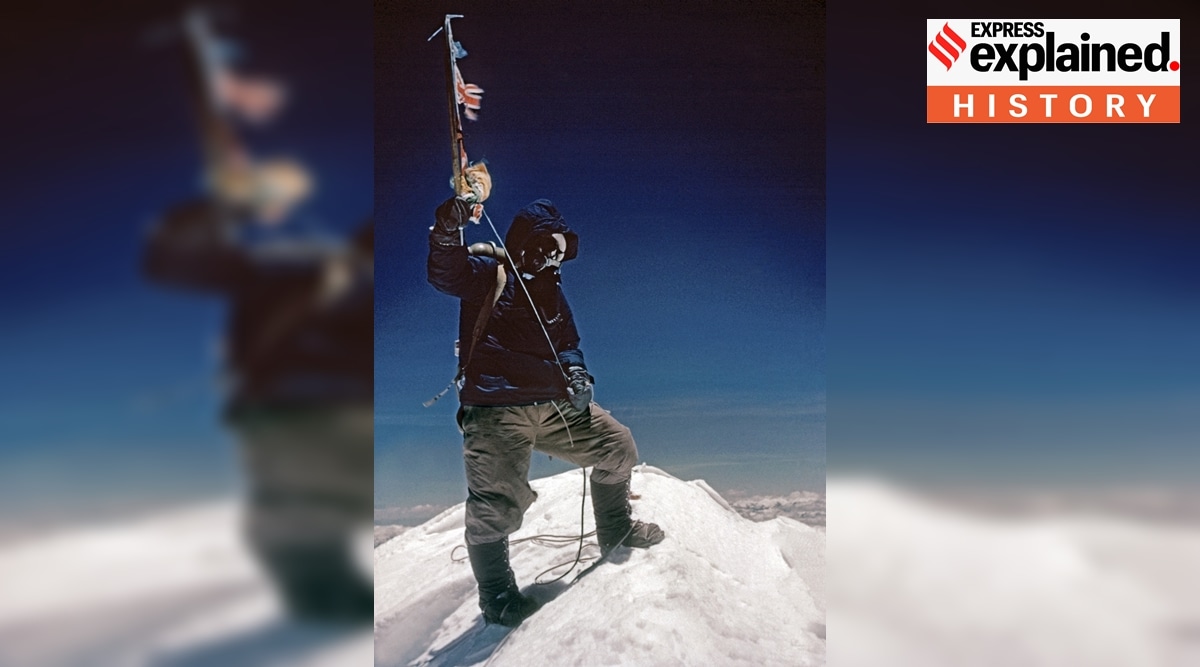Edmund Hillary and Tenzing Norgay completed the first confirmed ascent of Mount Everest on May 29, 1953. The duo reached the summit at 11.30 am, took photographs, and buried a cross and some sweets before making their way back.
Mount Everest, the highest mountain in the world (in terms of height above sea level), had been in the sights of mountaineers since the nineteenth century, when alpinists successfully scaled almost every significant peak in Europe. After that, the Himalayas became mountaineering’s final frontier with Mount Everest the ultimate prize.

However, first approaches to the towering peak were only made in the early 1920s. During the 1924 British expedition, the largest and most prepared at the time to summit the mountain, George Mallory and Andrew “Sandy” Irvine disappeared during a summit attempt – giving birth to one of mountaineering’s enduring mysteries.
Did Mallory and Irvine reach the summit? Was Everest actually conquered all the way back in 1924 – 29 years before Hillary and Norgay summited the peak?
The 1924 Everest expedition
The 1924 expedition was the third Everest expedition and the second one with a serious intention of scaling it. The previous two expeditions had figured out a possible climbing route up the northern side of the peak, and many expected Mount Everest to be finally conquered in 1924. The expedition was also by far the best prepared, with local porters and the latest equipment, notably bottled oxygen.
The expedition reached the Rongbuk Monastery near the base of Everest’s northern side on April 28. From there, it proceeded along the Rongbuk glacier to the icy slopes of the North Col, setting up three camps on the way. Finally, when weather permitted, four European mountaineers, Edward Norton, George Mallory, Harvard Somervell and Noel Odell, fixed ropes on the icy slopes of the North Col, setting up Camp IV at the altitude of 7000 m on May 21.
From the North Col, the planned route to the top went along the North and Northeast ridges of the mountain. After two failed attempts, George Mallory and Sandy Irvine set out for the summit from Camp IV on June 6.
George Mallory was a veteran of previous Everest expeditions and considered the best climber of his era. When asked why he wanted to climb Mount Everest by an NYT reporter, Mallory famously replied, “Because it’s there”. Sandy Irvine, on the other hand, was a relative novice, chosen due to his expertise in operating the oxygen apparatus – still rudimentary and prone to malfunction.
 George Mallory (leftmost, sitting) with other members of the pioneering 1921 expedition. (Wikimedia Commons)
George Mallory (leftmost, sitting) with other members of the pioneering 1921 expedition. (Wikimedia Commons)
On June 8, Noel Odell, from his position lower down on the mountain, saw Mallory & Irvine on the ridge, “nearing the base of the final pyramid”. The duo was five hours behind schedule but tantalisingly close to the summit. Mallory and Irvine would never be seen alive again.
Did they reach the top?
Odell was the last to see Mallory and Irvine alive. As per Odell, the duo climbed what is now known as the Second Step in under five minutes. The Second Step (at an altitude of 8610 m) is considered to be the hardest challenge on the path to Everest’s summit from the northern side. It was Odell’s claimed sighting which began the speculation about Mallory and Irvine’s climb – if they had indeed climbed the Second Step, it is likely they would have reached the summit.
Best of ExplainedThe double-whammy from India's falling farm exportsA political history of Chhattisgarh: From Ajit Jogi to Bhupesh BaghelExperts Explain: How to fix Mumbai's airClick here for more
However, if not unclimbable with the mountaineering skill and equipment of the time, the Second Step was definitely insurmountable in five minutes, as indicated by Odell. When the Chinese first climbed it in 1960, they took over three hours, despite having far superior equipment and almost half a century more of mountaineering knowledge to tap into. Most experts today believe that Odell instead saw the duo climb the First Step (at an altitude of 8564 m).
Furthermore, evidence from the duo’s high camp indicates they had issues with their oxygen equipment. At the altitude they were in, climbing without oxygen would have been near impossible. It was only in 1980 that legendary alpinist Reinhold Messner made the first ascent of Everest without supplemental oxygen.
 The north face of Mount Everest, with popular routes up the mountain. The green route shows the route Mallory and Irvine probably took. Cross number 1 indicates where Mallory’s body was found in 1999. (Wikimedia Commons, Full legend)
The north face of Mount Everest, with popular routes up the mountain. The green route shows the route Mallory and Irvine probably took. Cross number 1 indicates where Mallory’s body was found in 1999. (Wikimedia Commons, Full legend)
During the 1933 British Mount Everest expedition, Percy Wyn-Harris found Sandy Irvine’s ice axe some 250 yards (230 metres) east of the First Step and 60 feet (20 metres) below the ridge. The location of his body remains a mystery, though a Chinese climber claimed to have seen it in 1975.
Mallory’s body was discovered in 1999. It lay frozen at an altitude of around 8,156 m with evidence of fall injuries. However, Mallory’s Kodak camera, which he would have used to take pictures of the summit, remains missing, continuing to fuel speculation.
Most in the mountaineering fraternity believe that a successful summit by Mallory is highly unlikely. Conrad Anker, who found Mallory’s body in 1999 and has climbed Mount Everest while wearing gear that the 1924 expedition used, said that it was “possible, but highly improbable, that they made it to the top.”
Also Read | Explained: What does it take to climb Mount Everest? What are the risks involved?
Messner too reflects this view. “Suddenly they see a huge rock step towering over them … Scaling it is impossible – it is far too high, too smooth, too exposed … Having failed to surmount the Second Step, Mallory and Irvine begin their descent … Night is falling quickly. Their descent is made even more dangerous by a brewing snowstorm … Their oxygen runs out … Lethargy forces them to stop after every step, and they have difficulty finding secure footholds … The circumstances are ripe for an accident,” Messner said in an interview.
Hillary and Norgay remain the first to successfully ascend
Even if Mallory did manage to summit Mount Everest, he fell to his death on the way down.
As Edmund Hillary put it, “If you climb a mountain for the first time and die on the descent, is it really a complete first ascent of the mountain? I’m rather inclined to think, personally, that maybe it’s quite important, the getting down.”
Also Read | ‘The mountain is turning black’: Climbers air climate concern on 70th anniversary of maiden Mt Everest climb
Thus, Edmund Hillary and Tenzing Norgay’s 1953 summit remains the first successful one of Mount Everest.
Climbing in the Himalayas
While mountains have fascinated humans since the beginning of time, mountaineering as a sport began only in the 18th century, with the Age of Enlightenment in Europe. During the Golden Age of Alpinism – between 1854 and 1865 – European climbers successfully ascended almost any peak in the Alps worth climbing.
Most Read 1India vs South Africa, World Cup 2023 Highlights: Kohli’s century, Jadeja’s fifer help India beat South Africa by 243 runs 2When Gulzar sat silently with Tabu for one hour, offered her Maachis after that: ‘This relationship impacted my life the most’ 3Diwali 2023 Date: When is Diwali in 2023? 4After ‘letter’ to Foxconn to move AirPod unit to Bengaluru goes viral, Karnataka Deputy CM Shivakumar files complaint 5Rs 100 crore bank fraud: Court rejects CBI closure report in case against BJP leader Mohit Kamboj, his firm
The final frontier in mountaineering lay outside – in the Himalayas, which boasted the world’s highest peaks. Beyond the sport of climbing itself, Himalayan mountaineering, in its early days, was fuelled by colonial imperatives of exploring, surveying, and ultimately subduing the Himalayan frontier.
But climbing in the Himalayas was fundamentally different than in the Alps. For one, most peaks in the Alps are far more accessible than their Himalayan counterparts. This inaccessibility gave birth to expedition climbing – climbing became military-like with massive logistics operations to support the actual ascent.
Also ReadWhat happened on Oct 31, 1984: Recalling the assassination of Indira GandhiWho are the Palestinians?Bletchley Park: Where ‘computers’ helped the Allies win WWII, now hosting…39 years since Operation Bluestar: What led up to it, what happened
Second, the high peaks of the Himalayas were also significantly taller than the ones in the Alps – posing multiple novel challenges, including thinning air at high altitudes. It was only after the development of ‘reliable’ bottled oxygen that climbing in the Himalayas truly took off.
© The Indian Express Pvt Ltd



